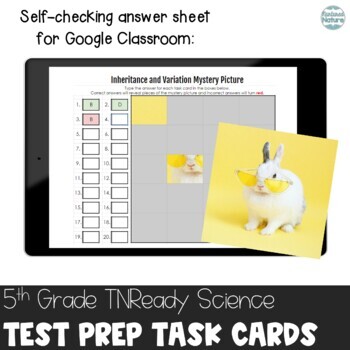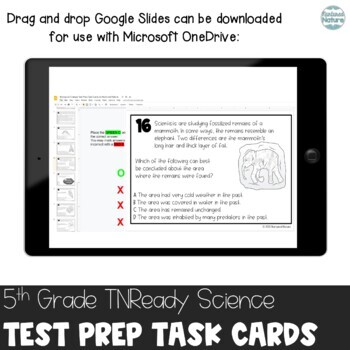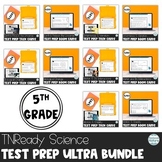5th Grade Test Prep Task Cards - Life Earth Physical Science - TNReady Review
- Zip
- Google Apps™
- Easel Activity
- Easel Assessment

What educators are saying
Products in this Bundle (5)
Bonus
Also included in
- Save 35% with this bundle of 110 5th Grade TNReady test prep task cards – with printable, Google, AND Boom cards. This bundle includes everything you need to review Earth’s Place in the Universe, Heredity, Biological Change, Matter and Its Interactions, and Motion and Stability. This set of 110 SciePrice $23.55Original Price $36.25Save $12.70
Description
Planning your TNReady test prep lessons? Save 20% by purchasing 5 sets of Science task cards in this bundle, including everything you need to review Earth’s Place in the Universe, Heredity, Biological Change, Matter and Its Interactions, and Motion and Stability. This set of 110 Science task cards is modeled after item sampler and practice test questions. It is aligned with Tennessee state Science standards for 5th Grade.
BUNDLE BONUS: This bundle includes a set of 10 task cards for standard 5.LS1 - From Molecules to Organisms: Structures and Processes. This bonus set of cards is exclusive to this bundle.
The PDF download includes the following, to allow for maximum flexibility:
1. ½ page task cards for printing
2. Full page answer sheets for printing
3. Full page answer key for printing
4. Link to Google Slides version of task cards, with drag and drop for answer selection
5. Link to self-checking Google Sheets pixel puzzle answer sheet
6. Link to Google Docs answer key showing completed pixel puzzle
Do you use TpT Easel? An Easel assessment version of the task cards is also included!
The following TN Science standard objectives are addressed:
5.ESS1 Earth’s Place in the Universe
1) Explain that differences in the apparent brightness of the sun compared to other stars is due to their relative distances from the Earth.
2) Research and explain the position of the Earth and the solar system within the Milky Way galaxy, and compare the size and shape of the Milky Way to other galaxies in the universe.
3) Use data to categorize different bodies in our solar system including moons, asteroids, comets, and meteoroids according to their physical properties and motion.
4) Explain the cause and effect relationship between the positions of the sun, earth, and moon and resulting eclipses, position of constellations, and appearance of the moon.
5) Relate the tilt of the Earth’s axis, as it revolves around the sun, to the varying intensities of sunlight at different latitudes. Evaluate how this causes changes in the day lengths and seasons.
6) Use tools to describe how stars and constellations appear to move from the Earth’s perspective throughout the seasons.
7) Use evidence from the presence and location of fossils to determine the order in which rock strata were formed.
5.LS1 From Molecules to Organisms: Structures and Processes
1) Compare and contrast animal responses that are instinctual versus those that are gathered through the senses, processed, and stored as memories to guide their actions.
5.LS3 Heredity: Inheritance and Variation of Traits
1) Distinguish between inherited characteristics and those characteristics that result from a direct interaction with the environment. Apply this concept by giving examples of characteristics of living organisms that are influenced by both inheritance and the environment.
2) Provide evidence and analyze data that plants and animals have traits inherited from parents and that variations of these traits exist in a group of similar organisms.
5.LS4 Biological Change: Unity and Diversity
1) Analyze and interpret data from fossils to describe organisms and their environments that existed long ago. Compare similarities and differences of those to living organisms and their environments. Recognize that most kinds of animals (and plants) that once lived on Earth are now extinct.
2) Use evidence to construct an explanation for how variations in characteristics among individuals within the same species may provide advantages to these individuals in their survival and reproduction.
5.PS1 Matter and Its Interactions
1) Analyze and interpret data from observations and measurements of the physical properties of matter to explain phase changes between a solid, liquid, or gas.
2) Analyze and interpret data to show that the amount of matter is conserved even when it changes form, including transitions where it seems to vanish.
3) Design a process to measure how different variables (temperature, particle size, stirring) affect the rate of dissolving solids into liquids.
4) Evaluate the results of an experiment to determine whether the mixing of two or more substances result in a change of properties.
5.PS2 Motion and Stability: Forces and Interactions
1) Test the effects of balanced and unbalanced forces on the speed and direction of motion of objects.
2) Make observations and measurements of an object’s motion to provide evidence that a pattern can be used to predict future motion.
3) Use evidence to support that the gravitational force exerted by Earth on objects is directed toward the Earth’s center.
4) Explain the cause and effect relationship of two factors (mass and distance) that affect gravity.
5) Explain how forces can create patterns within a system (moving in one direction, shifting back and forth, or moving in cycles), and describe conditions that affect how fast or slowly these patterns occur.
These are my favorite ways to use these task cards with my students:
-Hang the task cards around the room with tape. Give each student an answer sheet and clipboard. Set a timer and allow students to read and record answers for each card gallery walk style. When students are finished, project the Google Slides version and pixel puzzle side-by-side. Review the cards, pulling popsicle sticks to allow students to share and explain their answer choice. Enter student answers to complete the pixel puzzle as a class!
-Using Google Classroom, assign each student their own copy of the Google Slides version and Google Sheets pixel puzzle. Allow students to work independently to complete the cards, entering their answers in the pixel puzzle as they work. Each student receives immediate feedback as they work!
TEACHERS LIKE YOU SAID...
⭐⭐⭐⭐⭐ S.K. said: “My students loved these task cards and the puzzle! Super easy to implement and a great way to review for TN benchmark and state assessments. Thank you!”
⭐⭐⭐⭐⭐ Rhetta P. said: “Amazing resource! Great end of the year review!”
⭐⭐⭐⭐⭐ Amanda C. said: “This product was engaging for the students. It helped them review for the TNReady test.”
You may also like…
4th Grade TNReady Test Prep Boom Cards Bundle
Inherited Trait or Learned Behavior Pixel Art Puzzles
Producer Consumer Decomposer Pixel Art Puzzles
Inner or Outer Planets Pixel Art Puzzles
Copyright © Nurtured Nature.
Permission to copy for single classroom use only.
Please purchase additional licenses if you intend to share this product.






